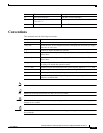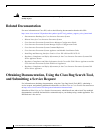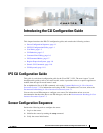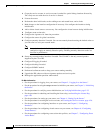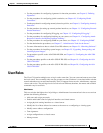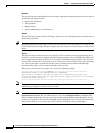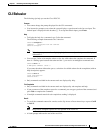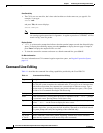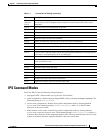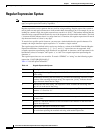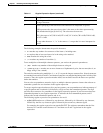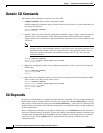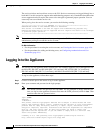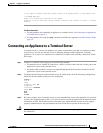
1-7
Cisco Intrusion Prevention System CLI Sensor Configuration Guide for IPS 7.1
OL-19892-01
Chapter 1 Introducing the CLI Configuration Guide
IPS Command Modes
IPS Command Modes
The Cisco IPS CLI has the following command modes:
• privileged EXEC—Entered when you log in to the CLI interface.
• global configuration—Entered from privileged EXEC mode by entering configure terminal. The
command prompt is
sensor(config)#.
• service mode configuration—Entered from global configuration mode by entering service
service-name. The command prompt is
sensor(config-ser)#, where ser is the first three
characters of the service name.
• multi-instance service mode—Entered from global configuration mode by entering service
service-name component-instance-name. The command prompt is
sensor(config-com)# where com
is the first three characters of the component instance name. The only multi-instance services in the
system are anomaly detection, signature definition, and event action rules.
Down
Arrow or
Ctrl-N
Returns to more recent commands in the history buffer after recalling commands with
the Up Arrow or Ctrl-P. Repeat the key sequence to recall successively more recent
commands.
Ctrl-A Moves the cursor to the beginning of the line.
Ctrl-B Moves the cursor back one character.
Ctrl-D Deletes the character at the cursor.
Ctrl-E Moves the cursor to the end of the command line.
Ctrl-F Moves the cursor forward one character.
Ctrl-K Deletes all characters from the cursor to the end of the command line.
Ctrl-L Clears the screen and redisplays the system prompt and command line
Ctrl-T Transposes the character to the left of the cursor with the character located at the cursor.
Ctrl-U Deletes all characters from the cursor to the beginning of the command line.
Ctrl-V Inserts a code to indicate to the system that the keystroke immediately following should
be treated as a command entry, not as an editing key.
Ctrl-W Deletes the word to the left of the cursor.
Ctrl-Y Recalls the most recent entry in the delete buffer. The delete buffer contains the last ten
items you deleted or cut.
Ctrl-Z Ends configuration mode and returns you to the EXEC prompt.
Esc-B Moves the cursor back one word.
Esc-C Capitalizes the word at the cursor.
Esc-D Deletes from the cursor to the end of the word.
Esc-F Moves the cursor forward one word.
Esc-L Changes the word at the cursor to lowercase.
Esc-U Capitalizes from the cursor to the end of the word.
Table 1-1 Command Line Editing (continued)
Keys Description



